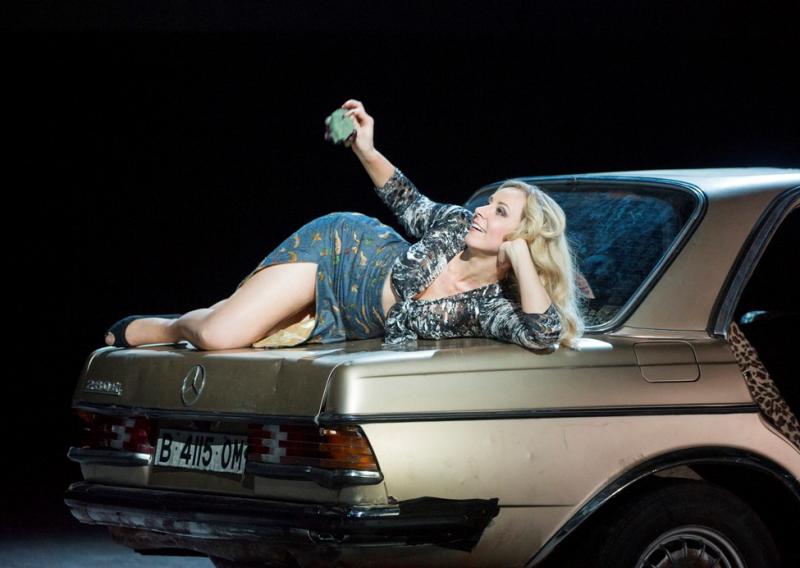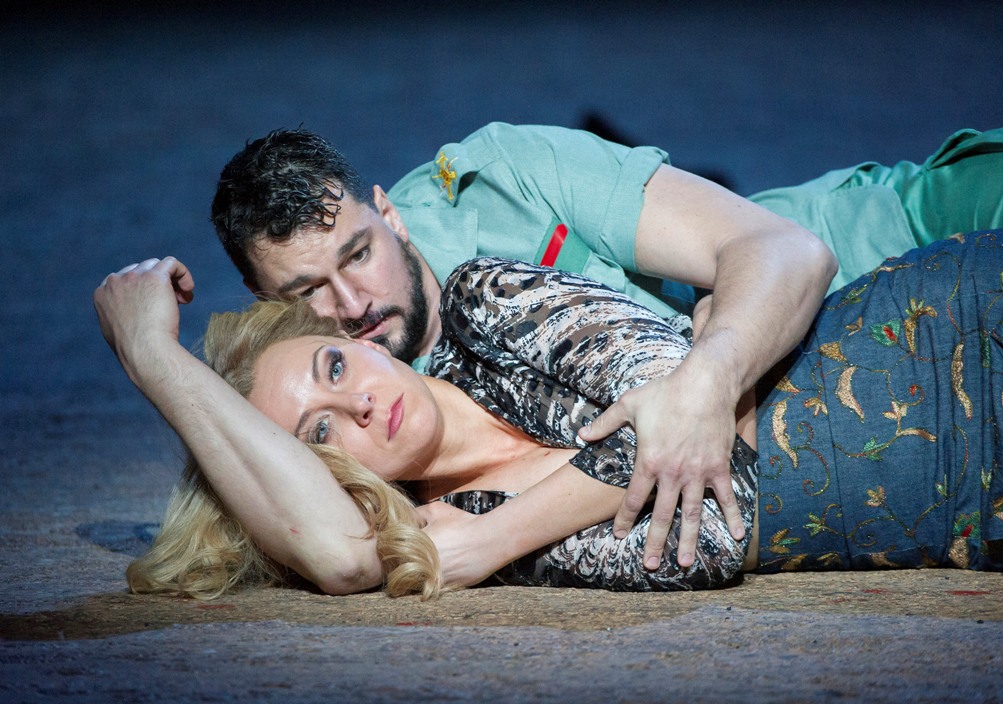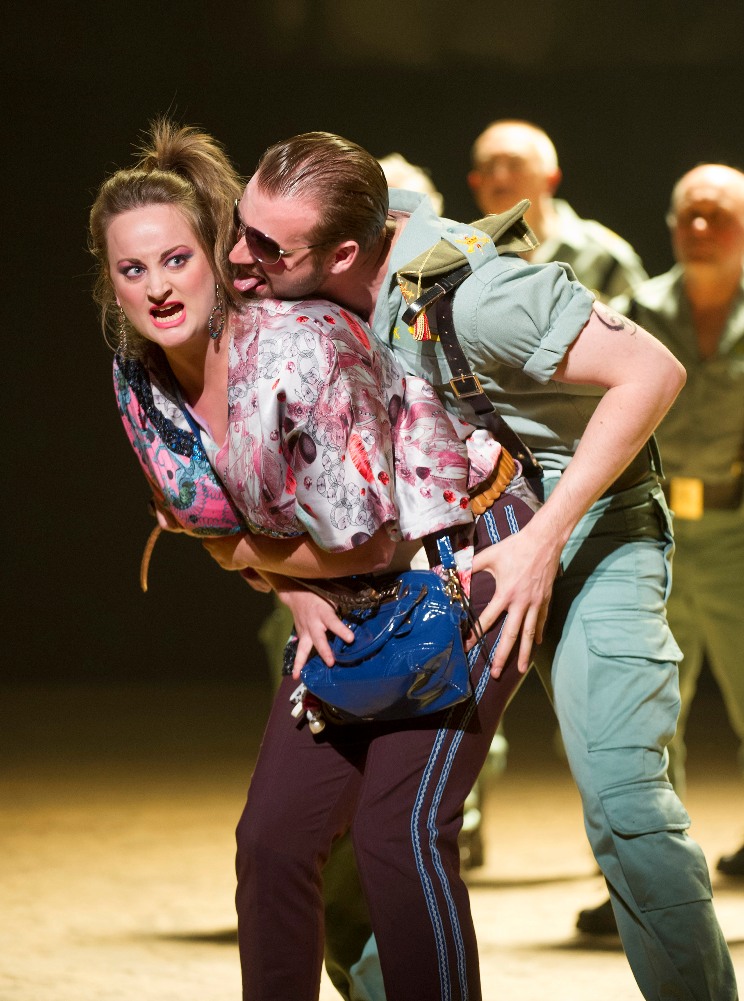Carmen, English National Opera | reviews, news & interviews
Carmen, English National Opera
Carmen, English National Opera
Broad brushstrokes and big voices in Calixto Bieito's pacey but half-cooked Bizet

Crotch-grabbing, suggestions of oral and anal sex, stylized punching and kicking and other casual violence offer diminishing returns in your standard Calixto Bieito production. Sometimes a scene or two flashes focused brilliance, which only makes you wonder why he doesn’t apply the same rigour throughout.
Even so, I'd challenge anyone to read a rather cheeky programme note interpreting Bieito’s production points and find much that tallied in the performance. Late Franco era? Chances are that won't be clear. The point of the Lillas Pastia figure, an innkeeper whose car is his bar, tottering drunkenly on at curtain-up to Carmen’s own fateful music? The borderland wasteland-plus-beach location? Didn’t come across to me. And centrally flawed, surely, is the notion of Carmen as nothing but victim; in her final confrontation with a jealousy-maddened José, she needs to be proud and frightened simultaneously, not just teetering around terrified.
 Yes, I buy the Romany girl as a bottle-blonde eastern European immigrant (albeit anachronistically located in the 1970s) with an outsider’s accent. Bieito’s first Carmen at ENO, Ruxandra Donose, was Romanian, and Justina Gringyte hails from Lithuania, but neither comes close to the proud, inflammatory sensuality of Latvian Elina Garanča, the only Carmen I’ve ever seen to convince on a stage and a bit too pricey for ENO. Our heroine needs to be her own person much more than someone who seems compelled to put it about a lot for cash.
Yes, I buy the Romany girl as a bottle-blonde eastern European immigrant (albeit anachronistically located in the 1970s) with an outsider’s accent. Bieito’s first Carmen at ENO, Ruxandra Donose, was Romanian, and Justina Gringyte hails from Lithuania, but neither comes close to the proud, inflammatory sensuality of Latvian Elina Garanča, the only Carmen I’ve ever seen to convince on a stage and a bit too pricey for ENO. Our heroine needs to be her own person much more than someone who seems compelled to put it about a lot for cash.
Gringyte has a vibrant, metally tone, a true mezzo, but needs to refine it, as the lighter Donose could, for the French suavity rife in Bizet’s version of Spain. Any Opéra Comique elements, such as the needlepoint quintet in Act Two, have to be sacrificed to Coliseum size, and there’s not a great deal of refinement anywhere, though Richard Armstrong’s conducing has dash and a confidence born of long-term experience even while it lacks a bit of rhythmic precision.
Impressive voices do fit the four main roles, though. This time we have a José of impeccable tenorial style in Eric Cutler (pictured above with Gringyte in Act Two), singing the much-debated top B flat in the Flower Song very quietly in head voice, as the score asks, and letting rip in the anguish of the last two acts, but with a finesse that should make his forthcoming Florestan and Lohengrin worth hearing.
 Eleanor Dennis (pictured left with George Humphreys' strong Corporal Moralès) is almost as impressive as the first of Bieito’s Micaëlas, the glorious Elizabeth Llewellyn, equally at home in long lyric-dramatic phrases, though she has to try and pull off the director’s tricky characterization of a come-hither, stand-back girl from the provinces.
Eleanor Dennis (pictured left with George Humphreys' strong Corporal Moralès) is almost as impressive as the first of Bieito’s Micaëlas, the glorious Elizabeth Llewellyn, equally at home in long lyric-dramatic phrases, though she has to try and pull off the director’s tricky characterization of a come-hither, stand-back girl from the provinces.
Fellow Scot - half-Scot, to be precise - Leigh Melrose returns as Escamillo, delivering a superbly energized Toreador Song with ringing top-note bravado; probably not his fault if the offstage repeat in the next act was virtually in a different key from the orchestra last night.
By then the visual impact of Alfons Flores’s geographically indeterminate set – and is it day or night in the outer acts, where bright lights sit ill with pocket-camera flashes? – has gone up several notches. There are two Mercedes in Act Two, the character as spiritedly sung by Clare Presland and one with an engine to thump on – and six in Act Three, enough to evoke the smugglers’ lair more vividly than you’ll ever have seen it before (though the women have no costume change, suggesting they’ve come straight on from Lillas Pastia’s zone before the interval), and no time for Carmen's brief liaison with José to sour). Queasy as it is, I don’t find it gratuitous that Merc’s pretty-in-pink, clearly abused daughter should be part of the package for the customs men.
Come the extra-bullring denouement, and Bieito reverts to convention, though rather beautifully – switching with the help of Bruno Poet’s ever versatile lighting from a raucous, waving crowd scene to Escamillo alone in toreador garb singing of his love for glammed-up Carmen. The final scene is predictably set within another ring of chalk; no surprises here and good, straightforward singing. You’ll not be bored, but don’t expect much finesse. That you'll probably get at Glyndebourne, an arena more fit for Bizet's crucial intimacies.
- Further performances of Carmen at ENO until 3 July, with a livescreening on 1 July
- David Nice's blog on the first run of the ENO Carmen and Garanča's Met Carmen
rating
Explore topics
Share this article
Add comment
The future of Arts Journalism
You can stop theartsdesk.com closing!
We urgently need financing to survive. Our fundraising drive has thus far raised £49,000 but we need to reach £100,000 or we will be forced to close. Please contribute here: https://gofund.me/c3f6033d
And if you can forward this information to anyone who might assist, we’d be grateful.

Subscribe to theartsdesk.com
Thank you for continuing to read our work on theartsdesk.com. For unlimited access to every article in its entirety, including our archive of more than 15,000 pieces, we're asking for £5 per month or £40 per year. We feel it's a very good deal, and hope you do too.
To take a subscription now simply click here.
And if you're looking for that extra gift for a friend or family member, why not treat them to a theartsdesk.com gift subscription?
more Opera
 Tosca, Welsh National Opera review - a great company reduced to brilliance
The old warhorse made special by the basics
Tosca, Welsh National Opera review - a great company reduced to brilliance
The old warhorse made special by the basics
 BBC Proms: The Marriage of Figaro, Glyndebourne Festival review - merriment and menace
Strong Proms transfer for a robust and affecting show
BBC Proms: The Marriage of Figaro, Glyndebourne Festival review - merriment and menace
Strong Proms transfer for a robust and affecting show
 BBC Proms: Suor Angelica, LSO, Pappano review - earthly passion, heavenly grief
A Sister to remember blesses Puccini's convent tragedy
BBC Proms: Suor Angelica, LSO, Pappano review - earthly passion, heavenly grief
A Sister to remember blesses Puccini's convent tragedy
 Orpheus and Eurydice, Opera Queensland/SCO, Edinburgh International Festival 2025 review - dazzling, but distracting
Eye-popping acrobatics don’t always assist in Gluck’s quest for operatic truth
Orpheus and Eurydice, Opera Queensland/SCO, Edinburgh International Festival 2025 review - dazzling, but distracting
Eye-popping acrobatics don’t always assist in Gluck’s quest for operatic truth
 MARS, Irish National Opera review - silly space oddity with fun stretches
Cast, orchestra and production give Jennifer Walshe’s bold collage their all
MARS, Irish National Opera review - silly space oddity with fun stretches
Cast, orchestra and production give Jennifer Walshe’s bold collage their all
 Káťa Kabanová, Glyndebourne review - emotional concentration in a salle modulable
Janáček superbly done through or in spite of the symbolism
Káťa Kabanová, Glyndebourne review - emotional concentration in a salle modulable
Janáček superbly done through or in spite of the symbolism
 Buxton International Festival 2025 review - a lavish offering of smaller-scale work
Allison Cook stands out in a fascinating integrated double bill of Bernstein and Poulenc
Buxton International Festival 2025 review - a lavish offering of smaller-scale work
Allison Cook stands out in a fascinating integrated double bill of Bernstein and Poulenc
 Tosca, Clonter Opera review - beauty and integrity in miniature
Happy surprises and a convincing interpretation of Puccini for today
Tosca, Clonter Opera review - beauty and integrity in miniature
Happy surprises and a convincing interpretation of Puccini for today
 Hamlet, Buxton International Festival review - how to re-imagine re-imagined Shakespeare
Music comes first in very 19th century, very Romantic, very French operatic creation
Hamlet, Buxton International Festival review - how to re-imagine re-imagined Shakespeare
Music comes first in very 19th century, very Romantic, very French operatic creation
 Falstaff, Glyndebourne review - knockabout and nostalgia in postwar Windsor
A fat knight to remember, and snappy stagecraft, overcome some tedious waits
Falstaff, Glyndebourne review - knockabout and nostalgia in postwar Windsor
A fat knight to remember, and snappy stagecraft, overcome some tedious waits
 Salome, LSO, Pappano, Barbican review - a partnership in a million
Asmik Grigorian is vocal perfection in league with a great conductor and orchestra
Salome, LSO, Pappano, Barbican review - a partnership in a million
Asmik Grigorian is vocal perfection in league with a great conductor and orchestra
 Semele, Royal Opera review - unholy smoke
Style comes and goes in a justifiably dark treatment of Handelian myth
Semele, Royal Opera review - unholy smoke
Style comes and goes in a justifiably dark treatment of Handelian myth

Comments
Watched this ( well, partly,
well said. it was appaulling
'WHO was the dismal looking
Read the review. It seemed
Read the review. It seemed clear to me - eventually - that she was Mercedes' traumatised daughter, being put out to sell to the customs officers in Act 3. As I wrote, much else wasn't clear, least of all that there was supposed to be a beach (Gibraltar or around?) In Bieito's Boris Godunov there is also an abused child, the Inn Hostess's daughter.
I also watched the live